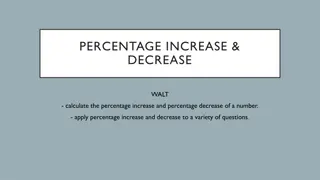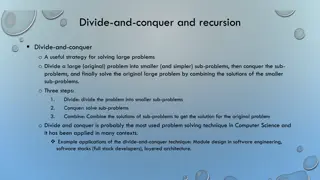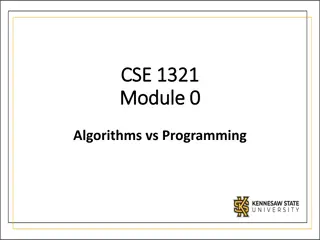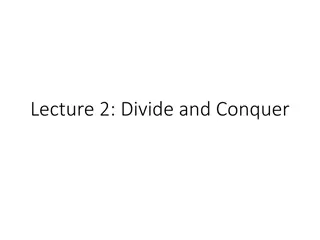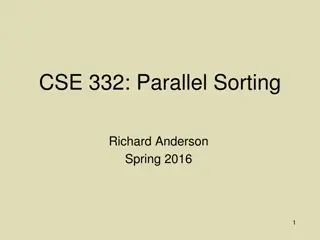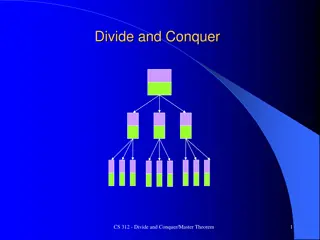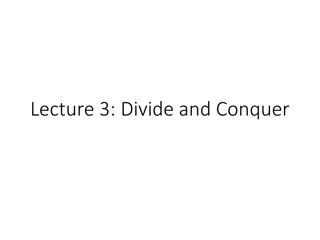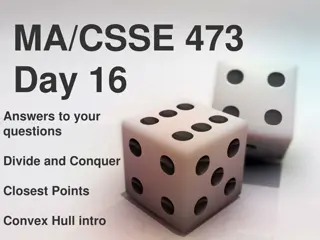Understanding Decrease and Conquer Technique in Algorithms
The decrease-and-conquer technique in algorithms leverages the relationship between a problem instance and its smaller instances to solve problems effectively. It involves decreasing by one, half, or a constant factor to iteratively solve problems. This method can be implemented recursively or iteratively, with examples like Insertion Sort showcasing its application in sorting algorithms.
Download Presentation

Please find below an Image/Link to download the presentation.
The content on the website is provided AS IS for your information and personal use only. It may not be sold, licensed, or shared on other websites without obtaining consent from the author. Download presentation by click this link. If you encounter any issues during the download, it is possible that the publisher has removed the file from their server.
E N D
Presentation Transcript
Decrease and Conquer 0750323 ALGORITHMS DR. RANEEM QADDOURA 0750323 Algorithms Philadelphia University Dr. Raneem Qaddoura Introduction to Design and Analysis of Algorithms Anany Levitin
Decrease and Conquer The decrease-and-conquer technique is based on exploiting the relationship between a solution to a given instance of a problem and a solution to its smaller instance. Once such a relationship is established, it can be exploited either top down or bottom up. The former leads naturally to a recursive implementation, although, as one can see from several examples in this chapter, an ultimate implementation may well be non-recursive. The bottom-up variation is usually implemented iteratively, starting with a solution to the smallest instance of the problem; it is called sometimes the incremental approach. There are three major variations of decrease-and-conquer: decrease by one decrease by half decrease by a constant decrease by a constant factor variable size decrease variable size decrease 0750323 Algorithms Philadelphia University Dr. Raneem Qaddoura Introduction to Design and Analysis of Algorithms Anany Levitin
Insertion Sort 0750323 Algorithms Philadelphia University Dr. Raneem Qaddoura Introduction to Design and Analysis of Algorithms Anany Levitin
Insertion Sort Problem of sorting: given a list of ? orderable items (e.g., numbers, characters from some alphabet, character strings), rearrange them in nondecreasing order. Insertion sort: A decrease-by-one technique to sorting an array A[0..n 1]. Following the technique s idea, we assume that the smaller problem of sorting the array A[0..n 2] has already been solved to give us a sorted array of size n 1: A[0] ... A[n 2]. How can we take advantage of this solution to the smaller problem to get a solution to the original problem by taking into account the element A[n 1]? Obviously, all we need is to find an appropriate position for A[n 1] among the sorted elements and insert it there. This is usually done by scanning the sorted subarray from right to left until the first element smaller than or equal to A[n 1] is encountered to insert A[n 1] right after that element. 0750323 Algorithms Philadelphia University Dr. Raneem Qaddoura Introduction to Design and Analysis of Algorithms Anany Levitin
Insertion Sort starting with A[1] and ending with A[n 1], A[i]is inserted in its appropriate place among the first i elements of the array that have been already sorted The basic operation of the algorithm is the key comparison A[j ]> v. (Why not j 0? Because it is almost certainly faster than the former in an actual computer implementation. Moreover, it is not germane to the algorithm: a better implementation with a sentinel eliminates it altogether.) 0750323 Algorithms Philadelphia University Dr. Raneem Qaddoura Introduction to Design and Analysis of Algorithms Anany Levitin
Insertion Sort The number of key comparisons in this algorithm obviously depends on the nature of the input. In the worst case, A[j ] > v is executed the largest number of times, i.e., for every j = i 1,..., 0. Since v = A[i], it happens if and only if A[j ] > A[i] for j = i 1,..., 0. (Note that we are using the fact that on the ith iteration of insertion sort all the elements preceding A[i] are the first i elements in the input, albeit in the sorted order.) Thus, for the worst-case input, we get A[0]> A[1] (for i = 1), A[1] > A[2] (for i = 2),...,A[n 2] > A[n 1] (for i = n 1). In other words, the worst-case input is an array of strictly decreasing values. The number of key comparisons for such an input is Thus, in the worst case, insertion sort makes exactly the same number of comparisons as selection sort 0750323 Algorithms Philadelphia University Dr. Raneem Qaddoura Introduction to Design and Analysis of Algorithms Anany Levitin
Insertion Sort In the best case, the comparison A[j ] > v is executed only once on every iteration of the outer loop. It happens if and only if A[i 1] A[i] for every i = 1,...,n 1, i.e., if the input array is already sorted in nondecreasing order. Thus, for sorted arrays, the number of key comparisons is This very good performance in the best case of sorted arrays is not very useful by itself, because we cannot expect such convenient inputs. However, almost-sorted files do arise in a variety of applications, and insertion sort preserves its excellent performance on such inputs. 0750323 Algorithms Philadelphia University Dr. Raneem Qaddoura Introduction to Design and Analysis of Algorithms Anany Levitin
Insertion Sort A rigorous analysis of the algorithm s average-case efficiency is based on investigating the number of element pairs that are out of order. It shows that on randomly ordered arrays, insertion sort makes on average half as many comparisons as on decreasing arrays, i.e., This twice-as-fast average-case performance coupled with an excellent efficiency on almost-sorted arrays makes insertion sort stand out among its principal competitors among elementary sorting algorithms, selection sort and bubble sort. 0750323 Algorithms Philadelphia University Dr. Raneem Qaddoura Introduction to Design and Analysis of Algorithms Anany Levitin
References Levitin, A. (2011). Introduction to the design & analysis of algorithms. Boston: Pearson. https://www.geeksforgeeks.org/comparison-among-bubble-sort-selection-sort-and-insertion- sort/ 0750323 Algorithms Philadelphia University Dr. Raneem Qaddoura Introduction to Design and Analysis of Algorithms Anany Levitin



